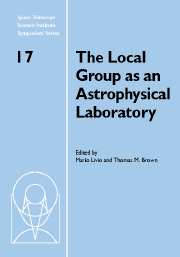 The Local Group as an Astrophysical Laboratory
The Local Group as an Astrophysical Laboratory Book contents
- Frontmatter
- Contents
- Participants
- Preface
- History of the Local Group
- Primordial nucleosynthesis
- Galactic structure
- The Large Magellanic Cloud: Structure and kinematics
- The Local Group as an astrophysical laboratory for massive star feedback
- Hot gas in the Local Group and low-redshift intergalactic medium
- Stages of satellite accretion
- The star formation history in the Andromeda halo
- Bulge populations in the Local Group
- The Local Group as a laboratory for the chemical evolution of galaxies
- Massive stars in the Local Group: Star formation and stellar evolution
- Massive Young Clusters in the Local Group
- Magellanic Cloud planetary nebulae as probes of stellar evolution and populations
- The old globular clusters: Or, life among the ruins
- Chemical evolution models of Local Group galaxies
The star formation history in the Andromeda halo
Published online by Cambridge University Press: 12 May 2010
- Frontmatter
- Contents
- Participants
- Preface
- History of the Local Group
- Primordial nucleosynthesis
- Galactic structure
- The Large Magellanic Cloud: Structure and kinematics
- The Local Group as an astrophysical laboratory for massive star feedback
- Hot gas in the Local Group and low-redshift intergalactic medium
- Stages of satellite accretion
- The star formation history in the Andromeda halo
- Bulge populations in the Local Group
- The Local Group as a laboratory for the chemical evolution of galaxies
- Massive stars in the Local Group: Star formation and stellar evolution
- Massive Young Clusters in the Local Group
- Magellanic Cloud planetary nebulae as probes of stellar evolution and populations
- The old globular clusters: Or, life among the ruins
- Chemical evolution models of Local Group galaxies
Summary
I present the preliminary results of a program to measure the star formation history in the halo of the Andromeda galaxy. Using the Advanced Camera for Surveys (ACS) on the Hubble Space Telescope, we obtained the deepest optical images of the sky to date, in a field on the southeast minor axis of Andromeda, 51′ (11 kpc) from the nucleus. The resulting color-magnitude diagram (CMD) contains approximately 300,000 stars and extends more than 1.5 mag below the main sequence turnoff, with 50% completeness at V = 30.7 mag. We interpret this CMD using comparisons to ACS observations of five Galactic globular clusters through the same filters, and through χ2-fitting to a finely-spaced grid of calibrated stellar population models. We find evidence for a major (∼30%) intermediate-age (6–8 Gyr) metal-rich ([Fe/H]> −0.5) population in the Andromeda halo, along with a significant old metal-poor population akin to that in the Milky Way halo. The large spread in ages suggests that the Andromeda halo formed as a result of a more violent merging history than that in our own Milky Way.
Introduction
One of the primary quests of observational astronomy is understanding the formation history of galaxies. An impediment to this research is the relative paucity of galaxies in the Local Group, which contains no giant ellipticals, and only two giant spirals-our own Milky Way and Andromeda. Fortunately, Andromeda (M31, NGC 224) is well situated for studying the formation of giant spiral halos, due to its proximity (770 kpc; Freedman & Madore 1990), small foreground reddening (EB-V = 0.08 mag; Schlegel, Finkbeiner, & Davis 1990), and low inclination (i ≍ 12.50°; de Vaucouleurs 1958).
- Type
- Chapter
- Information
- The Local Group as an Astrophysical LaboratoryProceedings of the Space Telescope Science Institute Symposium, held in Baltimore, Maryland May 5–8, 2003, pp. 111 - 126Publisher: Cambridge University PressPrint publication year: 2006
- 1
- Cited by


